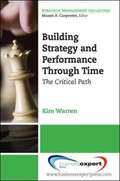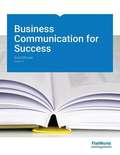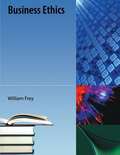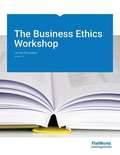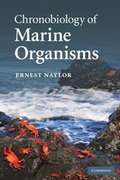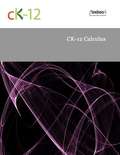- Table View
- List View
The Basic Elements of Music
by Catherine Schmidt-JonesExplanations (suitable for any age) of the basic elements of music, with suggested activities for introducing the each concept to children at early elementary school level. The course may be used by instructors not trained in music; all necessary definitions and explanations are included.
The Basics of General, Organic, and Biological Chemistry
by David W. Ball John W. Hill Rhonda J. J. ScottThe Basics of General, Organic, and Biological Chemistry by David W. Ball, John W. Hill, and Rhonda J. Scott is a new textbook offering for the one-semester GOB Chemistry course. The authors designed this book from the ground up to meet the needs of a one-semester course. It is 20 chapters in length and approximately 350-400 pages; just the right breadth and depth for instructors to teach and students to grasp. In addition, The Basics of General, Organic, and Biological Chemistry is written not by one chemist, but THREE chemistry professors with specific, complimentary research and teaching areas. David W. Ball's specialty is physical chemistry, John W. Hill's is organic chemistry, and finally, Rhonda J. Scott's background is in enzyme and peptide chemistry. These three authors have the expertise to identify and present only the most important material for students to learn in the GOB Chemistry course. These experienced authors have ensured their text has ample in-text examples, and "Test Yourself" questions following the examples so students can immediately check their comprehension. The end-of-chapter exercises will be paired, with one answered in the back of the text so homework can easily be assigned and self-checked.
Biology of Bats
by William A. WimsattBats had mastered flight eons before man's own lineage began. Their unique volitional mode was obviously advantageous, for adaptive radiation within the group has been little short of extraordinary. Today Chiroptera represent the second largest order of mammals in number of species and the largest in overall abundance; excluding man, and possibly rodents, they are also the most widely distributed land-based mammals.
Building Strategy and Performance
by Kim WarrenThe fundamental challenge facing business leaders is to drive performance into the future--the dynamics of strategy. To tackle this effectively, they need a clear understanding of what causes performance to improve or deteriorate and what power they have to change this trajectory for the better. Without this understanding, they risk making poor choices about their future--failing to exploit promising opportunities, pursuing unachievable aims, or falling victim to competitive and other threats. Building Strategy and Performance Through Time sets the agenda for building business strategy in powerful, actionable, and accessible terms. It gives executives clear frameworks for answering three fundamental questions: * Why is our business performance following its current path? * Where is it going if we carry on as we are? * How can we design a robust strategy to transform this future? The existing strategy tools most widely used help guide management's choices about where to compete--which customers to serve, with what products and services, and how to deliver those products and services to those customers effectively and profitably. While this choice is important, it is not often changed in any fundamental way; having found a reasonably strong and profitable position on these issues, few firms will, or should, set off in a new direction. But there is still much to be done to deliver that strategy, powerfully and sustainably over time. Many decisions need to be made, continually and holistically, across all functions of the business and adapted as conditions change from month to month and year to year. Pricing, product development, marketing, hiring, service levels, and other decisions cannot be made in isolation but must take into account other choices being made, elsewhere and at different times. Building Strategy and Performance Through Time explains a reliable, practical method, known as strategy dynamics, that creates a living picture of how an enterprise actually works and delivers performance. This picture shows exactly where the levers are that management controls and how to choose what to do, when, and how much, to accomplish your specific goals. It shows, too, how the same approach can be used to defeat competitors, cope with other outside forces, and keep delivering performance.
Business Communication for Success
by Scott McleanThis book is suited for Business Communication courses, but is also appropriate for Business English, Business Presentation, Professional Communication courses. Scott McLean brings his authoring expertise to this new communications textbook. Scott has authored textbooks in the areas of Speech Communication, Interpersonal Communication and Public Speaking. Business Communications for Success benefits from Scott's extensive understanding of how students learn the art of effective communication. Students are provided ample opportunity to engage with the concepts, vocabulary and models covered in the text, including role-playing exercises, journal writings, case studies, small-group activities, games, and self-assessment activities.
Business Communication for Success
by Scott McleanThis book is suited for Business Communication courses, but is also appropriate for Business English, Business Presentation, Professional Communication courses. Scott McLean brings his authoring expertise to this new communications textbook. Scott has authored textbooks in the areas of Speech Communication, Interpersonal Communication and Public Speaking. Business Communications for Success benefits from Scott's extensive understanding of how students learn the art of effective communication. Students are provided ample opportunity to engage with the concepts, vocabulary and models covered in the text, including role-playing exercises, journal writings, case studies, small-group activities, games, and self-assessment activities.
Business Communication for Success (Canadian Edition)
by Scott Mclean Murray MomanThis book is suited for Business Communication courses taught in Canada, but is also appropriate for Business English, Business Presentation, Professional Communication courses. The Canadian version was adapted by Murray Moman to include proper spelling and grammar for the Northern Territories. In addition, the examples are taken from Canadian companies and situations so students in Canada can truly relate to the textbook content.
Business English for Success
by Scott McleanBusiness English for Success is a creative solution to a common challenge across Business Communication courses: Business English or Business Presentations? Some classes place an equal emphasis on oral and written communication. If that's the case for you check out our free online text Business Communication for Success. If, however, your class places the emphasis squarely on written communication and writing proficiency, then Business English for Success is for you. Business English for Success provides instruction in steps, builds writing, reading, and critical thinking, and combines comprehensive grammar review with an introduction to paragraph writing and composition. This step-by-step approach provides a clear path to student-centered learning. A wide range of writing levels and abilities are addressed, helping each student prepare for the next writing or university course.
Business Ethics
by William FreyBusiness Ethics is a derived copy from the Corporate Governance course previously published in Connexions. While many courses using this title place emphasis on applying classical philosophical and ethical theory, this course's approach is decidedly interdisciplinary and practical. It is not designed as a socio-humanistic elective, a service philosophy course, or even an applied philosophical ethics course but as a laboratory, skills-based course where students develop, practice, and refine decision-making and problem-solving strategies that they will carry with them into the world of business practice. Emphasis has been placed on responding to the four ethical themes identified by the AACSB ethics task force: Ethical Leadership, Ethical Decision-Making, Social Responsibility, and Corporate Governance. Modules include (1) theory building activities (responsibility, rights, virtue), (2) problem specification frameworks emphasizing socio-technical system building and analogies with design, (3) specific modules responding to AACSB ethics themes (moral ecologies, corporate social responsibility, corporate governance, and a history of the modern corporation) and (4) modules that provide the course with a capstone, integrative experience (Business Ethics Bowl, Social Impact Statement Reports, and Corporate Ethics Compliance Officer Reports). While a quick glance shows that this collection holds more modules than can possibly be covered in a single semester, this approach gives the user flexibility as to the method used for integrating ethics into the business administration curriculum. Modules can be recombined into different standalone courses such as business ethics, business/government/society, or environment of organizations. Since each module can be covered independently, they can be integrated into the business administration curriculum as specific interventions in mainstream business courses in areas like accounting, finance, management, information systems, human resources or office administration. (In fact many have been written for and tested in these circumstances.) Business Ethics has been developed through the NSF-funded project, "Collaborative Development of Ethics Across the Curriculum Resources and Sharing of Best Practices," NSF SES 0551779.
The Business Ethics Workshop v 1.0
by James BrusseauOn a good day in the business ethics classroom discussion charges forward; students have read the assigned case study, they’re engaged by the conflict and want to work through it. Then, there’s a bad day: students didn’t bother to do the reading and the hour sags listlessly. The key to going the first way is case studies that students want to read, and The Business Ethics Workshop by James Brusseau provides them with reality and engagement. Reality: No stilted and contrived stories about Steve Smith and Jane Jones. Excerpts from blogs and newspapers bring the weight—and provocation—of the world as it’s actually happening to the classroom.
The Business Ethics Workshop v 1.0
by James BrusseauOn a good day in the business ethics classroom discussion charges forward; students have read the assigned case study, they're engaged by the conflict and want to work through it. Then, there's a bad day: students didn't bother to do the reading and the hour sags listlessly. The key to going the first way is case studies that students want to read, and The Business Ethics Workshop by James Brusseau provides them with reality and engagement. Reality: No stilted and contrived stories about Steve Smith and Jane Jones. Excerpts from blogs and newspapers bring the weight--and provocation--of the world as it's actually happening to the classroom.
Business Fundamentals
by Global Text ProjectBusiness Fundamentals was developed by the Global Text Project, which is working to create open-content electronic textbooks that are freely available on the website http://globaltext.terry.uga.edu. Distribution is also possible via paper, CD, DVD, and via this collaboration, through Connexions. The goal is to make textbooks available to the many who cannot afford them. For more information on getting involved with the Global Text Project or Connexions email us at drexel@uga.edu and dcwill@cnx.org.
Business Information Systems: Design an App for That
by Raymond D. Frost Jacqueline C. Pike Lauren N. Kenyo Sarah E. PelsStudents in introductory Management Information Systems (MIS) courses often ask what a career in MIS looks like. Lacking a clear vision, they make their own assumptions. Often they assume the career involves programming with little human interaction. That MIS is a technical field could not be further from the truth. MIS job descriptions typically require candidates to be able to collaborate, communicate, analyze needs and gather requirements. They also list the need for excellent written and communication skills. In other words, MIS workers are constantly interacting with other people both inside and outside the organization. They are coming up with creative solutions to business problems. Business Information Systems by Frost, Pike, Kenyo and Pels is designed to help students get a feel for what a career in MIS would be like. The authors' students report that they learn more about information systems from their internships than from their IS courses. Consequently, they designed a book that looks very much like an internship--an introduction to the field followed by a substantial project. The authors begin Unit 1 by introducing the information systems landscape. The unit kicks off with a discussion of all the usual suspects: the information systems triangle, the systems development life cycle, transaction systems (ERP, SCM, CRM), collaboration systems, and business intelligence systems. Other aspects of the landscape such as usability, outsourcing, database concepts and so forth are introduced throughout a chapter in unit 2 where they fit in naturally with the flow of the project. Unit 2 is the substantial project which runs over a number of chapters. Students will plan, build, and develop a proposal for an iPhone application. They will develop a very realistic mockup. They also build a website to help market and support the app. Students are engaged because the project is fun and feels real. However, they are simultaneously learning business concepts and MIS skills. With Designing Information Systems, even as freshmen, you can give your students an experience that emulates MIS in operation. Business Information Systems: Design an App for That by Frost, Pike, Kenyo and Pels is a text that will help students learn Information Systems by doing Management Information Systems. Request a desk copy or examine the book online now to see how this text might work in your course or department.
Business Law and the Legal Environment
by Don Mayer Daniel M. Warner George J. Siedel Jethro K. LiebermanMayer, Warner, Siedel and Lieberman's Business Law and the Legal Environment is an up-to-date textbook with comprehensive coverage of legal and regulatory issues — and organized to permit instructors to tailor the materials to their particular approach. The authors take special care to engage students by relating law to everyday events with which they are already familiar with their clear, concise and readable style. Business Law and the Legal Environment provides students with context and essential concepts across the entire range of legal issues with which managers and business executives must grapple. The texts provide the vocabulary and legal acumen necessary for business people to talk in an educated way to their customers, employees, suppliers, government officials — and to their own lawyers.
Business Law and the Legal Environment: Executive MBA Edition
by Don Mayer Daniel M. Warner George J. Siedel Jethro K. LiebermanMayer, Warner, Siedel and Lieberman's Business Law and the Legal Environment (EMBA Edition) is an up-to-date textbook especially designed for students in EMBA programs. The text is organized to permit instructors to tailor the materials to their particular approach. The authors take special care to engage students by relating law to everyday events with their clear, concise and readable style. After introductory chapters covering the legal environment of business, Business Law and the Legal Environment (EMBA Edition) provides students with context and essential legal concepts relating to contracts, products liability, agency law, partnerships, corporations and government regulation. The text provides the vocabulary and legal savvy they will need to talk in an educated way to customers, suppliers, employees, creditors, shareholders, government regulators and other stakeholders — and to their own lawyers. With Business Law and the Legal Environment (EMBA Edition), the authors have created a text that not only has both case summaries and excerpted cases, but one that you can easily customize by deleting chapters, reordering the content, adding your own material, and even editing at the line level with Flat World's easy-to-use MIYO (Make It Your Own) Platform. The free online version of the text includes embedded links to law-related videos at YouTube and other online sites for easy access by students and instructors.
Business Law and the Legal Environment: Master of Accountancy Edition
by Don Mayer Daniel M. Warner George J. Siedel Jethro K. LiebermanMayer, Warner, Siedel and Lieberman's Business Law and the Legal Environment: MAcc Edition is an up-to-date textbook designed for students in Master of Accounting programs. The text is organized to permit instructors to tailor the materials to their particular approach. The authors take special care to engage students by relating law to everyday events with their clear, concise and readable style. After introductory chapters covering the legal environment of business, Business Law and the Legal Environment: MAcc Edition provides students with context and essential legal concepts that accounting professionals must understand, including contracts, sales, commercial paper, debtors and creditors rights, intellectual property, agency law, partnerships, corporations, and regulatory law. The text provides the vocabulary and legal savvy students will need when working in the accounting function or on engagements. With Business Law and the Legal Environment: MAcc Edition, the authors have created a text that not only has both case summaries and excerpted cases, but one that you can easily customize by deleting chapters, reordering the content, adding your own material, and even editing at the line level with Flat World's easy-to-use MIYO (Make It Your Own) Platform. The free online version of the text includes embedded links to law-related videos at YouTube and other online sites for easy access by students and instructors.
Business Law and the Legal Environment
by Don Mayer Daniel M. Warner George J. Siedel Jethro K. LiebermanMayer, Warner, Siedel and Lieberman's Business Law and the Legal Environment is an up-to-date textbook with comprehensive coverage of legal and regulatory issues -- and organized to permit instructors to tailor the materials to their particular approach. The authors take special care to engage students by relating law to everyday events with which they are already familiar with their clear, concise and readable style. Business Law and the Legal Environment provides students with context and essential concepts across the entire range of legal issues with which managers and business executives must grapple. The texts provide the vocabulary and legal acumen necessary for business people to talk in an educated way to their customers, employees, suppliers, government officials -- and to their own lawyers.
Chronobiology of Marine Organisms
by Ernest NaylorDo intertidal organisms simply respond to the rise and fall of tides, or do they possess biological timing and navigation mechanisms that allow them to anticipate when conditions are most favourable? How are the patterns of growth, development and reproduction of some marine plants and animals related to changes in day-length or to phases of the moon? The author describes how marine organisms, from single cells to vertebrates, on sea shores, in estuaries and in the open ocean, have evolved inbuilt biological clockwork and synchronisation mechanisms which control rhythmic processes and navigational behaviour, permitting successful exploitation of highly variable and often hostile environments. Adopting a hypothesis-testing and experimental approach, the book is intended for undergraduate and postgraduate students of marine biology, marine ecology, animal behaviour, oceanography and other biological sciences and also as an introduction for researchers, including physiologists, biochemists and molecular biologists entering the field of chronobiology.
CK-12 21st Century Physics Flexbook: A Compilation of Contemporary and Emerging Technologies
by Ck-12 FoundationPhysics textbook
CK-12 Advanced Probability and Statistics
by Ck-12 FoundationCK-12 Foundation's Advanced Probability and Statistics FlexBook covers the following chapters: An Introduction to Analyzing Statistical Data - Students learn definitions of statistical terminology, and review data, measures of center, and measures of spread. Visualizations of Data - histograms and frequency distributions, common graphs and data plots, and box-and-whisker plots. An Introduction to Probability - events, sample spaces, probability, compound events, the complement of an event, conditional probability, and basic counting rules. Discrete Probability Distribution - random variables, probability distribution for a discrete random variable, mean and standard deviation of discrete random variables and the Binomial Probability Distribution. Normal Distribution - standard normal probability distribution, the density curve of the normal distribution, and applications of the normal distribution. Planning and Conducting an Experiment or Study - surveys, sampling and experimental design. Sampling Distributions and Estimations - sampling distributions and the Central Limit Theorem. Hypothesis Testing - The P-value, testing a proportion hypothesis, testing a mean hypothesis, and testing a hypothesis for dependent and independent samples. Regression and Correlation - scatterplots and linear correlation, Least-Squares regression, inferences about regression, and an introduction to multiple regression. Chi-Square- the Goodness-of-Fit test, test of independence, and testing one variance. Analysis of Variance and the F-Distribution - the F-Distribution and testing two variances, the One-Way ANOVA test, and the Two-Way ANOVA test. Non Parametric Statistics - nonparametric statistics, the rank sum test and rank Correlation, and the Kruskal-Wallis test.
CK-12 Advanced Probability and Statistics Second Edition Volume 1
by Ck-12 FoundationAn open source textbook.
CK-12 Algebra I
by Ck-12 FoundationCK-12 Foundation's Algebra FlexBook is an introduction to algebraic concepts for the high school student. Topics include: Equations & Functions, Real Numbers, Equations of Lines, Solving Systems of Equations & Quadratic Equations.
CK-12 Calculus
by Ck-12 FoundationCK-12 Foundation's Single Variable Calculus FlexBook covers the following chapters: Functions, Limits, and Continuity - A review of the basics of functions is given. Students use linear approximations to study the limit process, before a more formal treatment of limits is given. Differentiation - Students explore instantaneous rate of change, and the relationship between continuity and differentiability. The Chain Rule and implicit differentiation are reviewed. Applications of Derivatives - Students gain practice with using the derivatives in related rates problems. Additional topics include The First Derivative Test, The Second Derivative Test, limits at infinity, optimization, and approximation errors. Integration - This chapter includes indefinite integrals calculus, initial value problems, definite integrals, the Fundamental Theorem of Calculus, integration by substitution, and numerical integration. Applications of Integration - This chapter includes applications of the definite integral, such as calculating areas between two curves, volumes, length of curves, and other real-world applications in physics and statistics. Transcendental Functions - This chapter includes differentiation and integration of logarithmic and exponential functions, exponential growth and decay, derivatives and integrals involving inverse trigonometric functions, and L'Hospital's Rule. Integration Techniques - Students explore integration by substitution, integration by parts, integration by partial fractions, trigonometric integrals, trigonometric substitutions, and improper integrals. Infinite Series - This chapter introduces the study of sequences and infinite series. The properties presented describe the behavior of a sequence or series, including whether a sequence approaches a number or an infinite series adds to a number.


